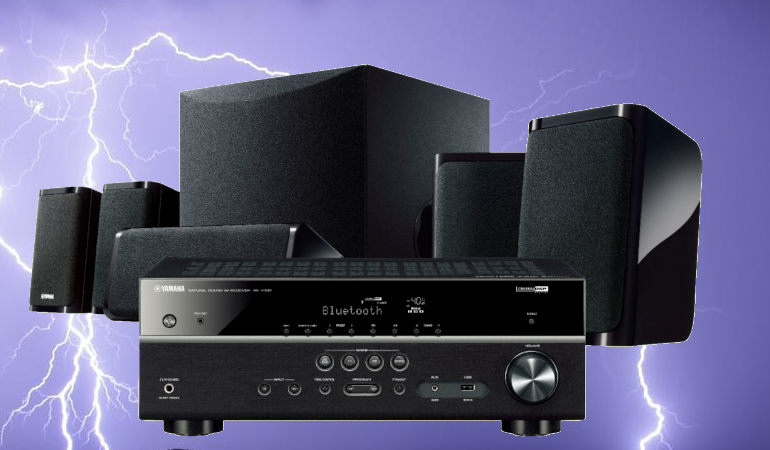A Surge Protector is Not Enough for Your Home Theater Equipment!
We all know that surge protectors are important. Even if you don’t live in areas where there are frequent outages (does such a magical land exist?) or lightning strikes, any power fluctuation can put your AV gear at risk. We all likely have a box of surge protectors somewhere and use them to expand the number of outlets as well as protect our electronics. But surge protectors are not enough for your home theater equipment. They work just fine for most electronics, but they are completely inadequate for your AV gear. Let’s discuss.
How Surge Protectors Work (and Fail)
In general, surge protectors divert excess electricity away from your gear into the grounding wire. If they are overtaxed, they may have a fuse that will sacrifice itself to protect your gear. A surge protector is sacrificial by nature. Even the ones without fuses can burn out with one strong surge. But what would you rather replace? A surge protector or your expensive home theater equipment?
This all sounds great in theory, but there are some problems. Low-quality surge protectors may not react fast enough to protect more sensitive electronic gear (like your home theater equipment). In addition, they may not be powerful enough to protect from the most powerful surges. Also, many will continue to provide power even after they have lost their fuse or their ability to divert surges. Some will have lights or indicators to let you know that your gear is no longer protected. But is that enough? How often do you look at your surge protectors?
Avenues of Ingress
“That’s fine,” you say. “I’ll just spend more and get a good surge protector (or maybe one of those fancy power conditioners) for my home theater equipment.”
That’s a great thought. But you can’t stop there. Your home theater has more avenues of ingress for surges than just the power cords. Most electronics plug into the wall. No other cables of any kind are attached. But think about your home theater equipment. How many cables are there? Tons! Everything is connected to everything else. Speakers to AV receiver, AV receiver to all your sources and display, and more.
If any of those devices are connected to the wall for power, you’ve defeated your surge protector. If any of those devices (specifically your cable box or modem) is connected to a wire that comes into your home from the outside, you’ve defeated your surge protector.

But the Warranty?
Surge protectors often come with warranties. They’ll claim $10,000 or $100,000 or more of replacement cost. That sounds great in theory. But, as you’d expect, they are looking for any reason NOT to pay. If you didn’t protect every avenue of ingress for surges to get to your home theater equipment, they aren’t going to pay. If that surge came from your Internet or cable line, you can bet they are going to reject your claim
Electricity is like water. It will take the path of least resistance. Lightning doesn’t just strike power lines. It can surge through cable and telephone lines as well. And once it has bypassed your surge protector, it will bounce around your home theater equipment through all those cables that connect them together.
How To Protect Your Home Theater from Surges
First, buy a quality surge protector and make sure it is operating properly. Get something with a light on it or, better yet, get one that is designed to protect your home theater gear.
Next, make sure that every piece of gear that is attached to an external wire is protected. This includes your modem and cable box. Quality surge protectors and battery backups will include connections for coax cables. Your cable provider will tell you not to use these. DON’T LISTEN. They are worried (rightfully so) that you’ll experience signal loss. But a slightly weaker Internet or cable signal is better than losing all your gear in a lightning strike.
Lastly, whole home surge protectors are not enough protection for your home theater equipment. While they are generally more robust than surge protector power strips, they don’t do anything to protect you from surges from other avenues. While they may be a good solution so you don’t have to think about protecting every outlet, they aren’t enough.
Take Away
Got a laptop or lamp or floor fan you want protected? A surge protector is fine for those jobs. But for your home theater equipment, you need to protect every avenue from surges. That includes your cable and Internet lines. Once you’ve done that, you should be as protected as you can be.



Thank you for explaining this, Tom.
I’ll have to look at our setup regarding the internet.
I have an OTA antenna inside our attic; is this something I need to be worried about? I don’t know if lightning is so strong to burn through the entire roof and then have enough juice to run through the coaxial cables. Then again, I might just be naive…
Anyway, thanks again for the well-written article.
I would not be worried about an antenna inside the house. If you had an old school one on the roof however…
Thanks for the response, Tom. Much appreciated.